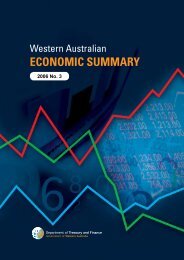2012-13 Government Mid-year Financial Projections Statement
2012-13 Government Mid-year Financial Projections Statement
2012-13 Government Mid-year Financial Projections Statement
- No tags were found...
You also want an ePaper? Increase the reach of your titles
YUMPU automatically turns print PDFs into web optimized ePapers that Google loves.
<strong>2012</strong>-<strong>13</strong> <strong>Government</strong> <strong>Mid</strong>-<strong>year</strong> <strong>Financial</strong> <strong>Projections</strong> <strong>Statement</strong>Industrial production in China has clearly slowed over the past <strong>year</strong>. As expected, theadjustment to this softening in demand has occurred through lower commodity prices.The immediate risk to domestic demand in Western Australia has been offset to someextent by the large pipeline of major resource projects that are already under construction.These projects are difficult to wind back once commenced, particularly for major LNGprojects which account for over 85% of the value of resource projects under construction.In the long run, the continued industrialisation of China is likely to support externaldemand. A rebalancing of China’s growth away from investment could assist withensuring more sustainable growth in future <strong>year</strong>s.Domestic RisksThe decline in dwelling investment in 2011-12 was greater than forecast in the<strong>2012</strong>-<strong>13</strong> Budget, despite evidence of a pick-up in underlying housing demand.A recovery in housing demand is expected to support established house prices in <strong>2012</strong>-<strong>13</strong>and flow through to a pick-up in dwelling investment. However, there is a risk thatconditions may remain subdued due to the large outstanding stock of household debt andrelatively low (but improving) housing affordability 1 .The $US/$A exchange rate remains high by historical standards despite weaker globaldemand and declines in commodity prices over the past <strong>year</strong>. This reflects a relativelyweak US dollar, interest rate differentials between Australia and other countries, andforeign demand for Commonwealth <strong>Government</strong> securities. The strong Australian dollaracts as a constraint on the State’s royalty revenue, as most commodity exports are pricedin US dollars. It also reduces the cost competitiveness of new resource projects inWestern Australia relative to other countries. These disadvantages are partly offset bylower import prices, which increase the purchasing power of consumers.Western Australia’s population growth remains stronger than the rest of Australia,supported by high levels of net overseas migration. This presents some upside risk togrowth, by potentially boosting household consumption and inflation, and flowingthrough to housing demand and higher house prices. Strong population growth has alsoincreased demand for services and infrastructure provided by the Western Australianpublic sector.Western Australia’s strong economic performance over the past <strong>year</strong> seems to beinconsistent with recent indicators of weaker consumer and business sentiment at theState level. Measures of consumer confidence have been relatively weak over the past<strong>year</strong>, despite strong growth in retail sales in Western Australia and cuts in the cash rate bythe Reserve Bank of Australia, totalling 175 basis points since October 2011. Businesssentiment in Western Australia also appears to have moderated, with resource firms beingmore cautious following recent volatility in commodity prices.1While housing affordability has improved in recent <strong>year</strong>s, it is still relatively low by historical standards. Housing affordabilityhas been improving on the back of modest average annual growth in house prices (as measured by the ABS established houseprice index) of 0.6% over the past five <strong>year</strong>s (from 2007 to <strong>2012</strong>), compared to growth in average weekly earnings of 6.2%per <strong>year</strong>. By contrast, house prices in the previous five <strong>year</strong>s (using the latest data) grew at an unsustainable rate of 20.0%per <strong>year</strong>, compared to earnings growth of 6.4% per <strong>year</strong>.68
















